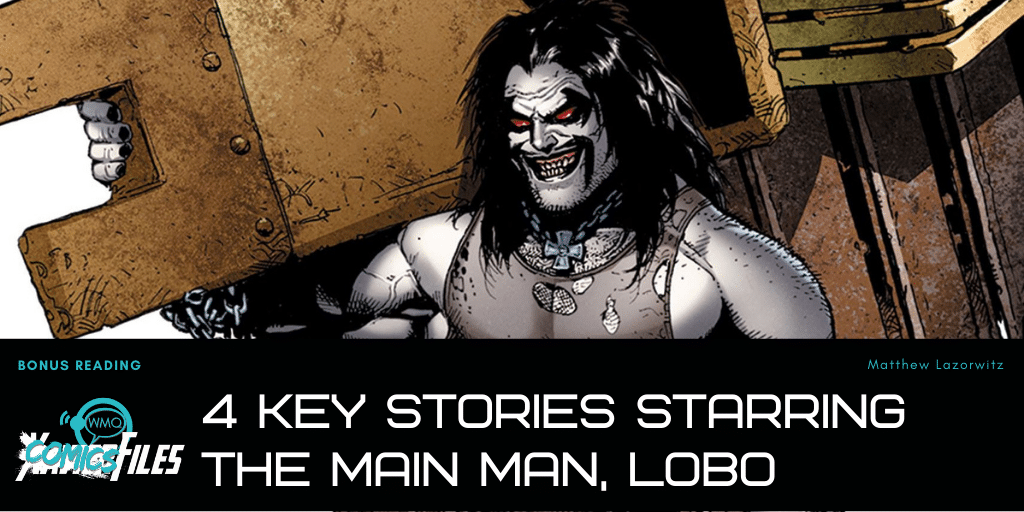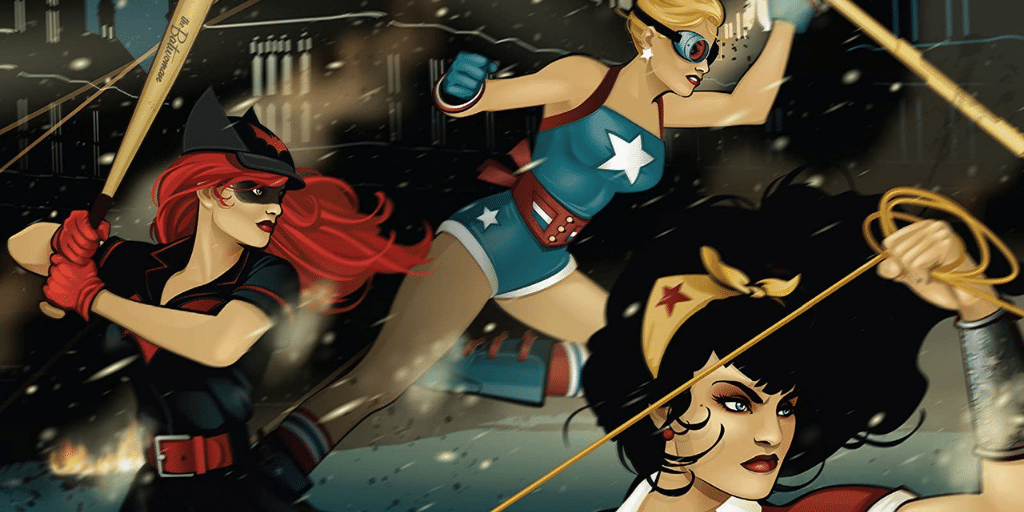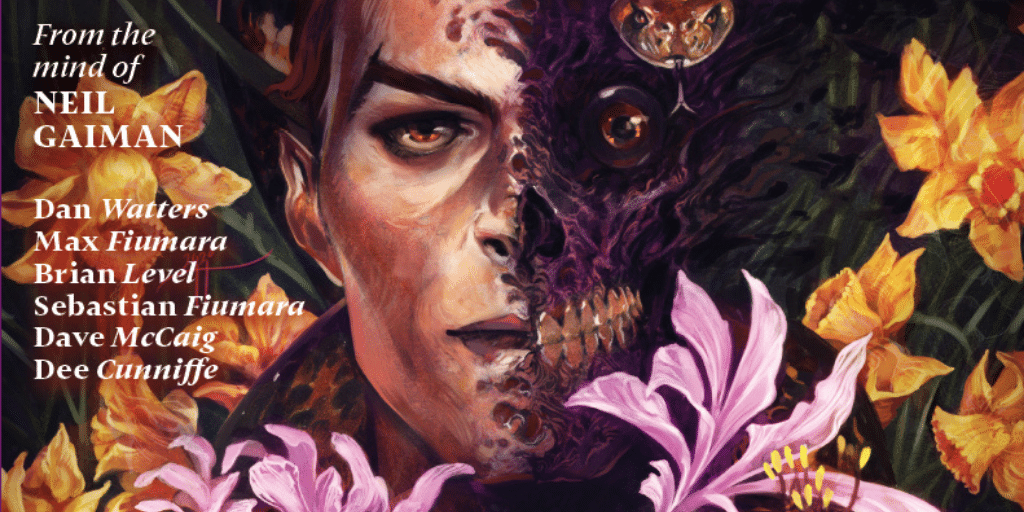
I’m going to be up front: I don’t like Lobo.
He’s everything that’s wrong with the ultraviolent characters of the early ’90s. And the thing a lot of his fans forget about is this: He’s supposed to be unlikable and to represent everything wrong with those types of characters.
When introduced in 1983’s “Omega Men” #3, Lobo was a villain, and when he transitioned over to “L.E.G.I.O.N.” he wasn’t designed to be some cool anti-hero but a parody of “cool anti-heroes.” As is often the case, though, some people don’t get parody and assume it’s serious, and so Lobo became what he was meant to lampoon.
As he’s headlining this week’s “Dark Nights: Death Metal: Infinite Hour Exxxtreme!” one-shot, I went and did some digging, looking for stories featuring Lobo that either played to that parody angle or did something different and interesting with him. So here are four Lobo stories you might want to check out.
Lobo #1-4

The original Lobo miniseries, from co-creator Keith Giffen, writer Alan Grant and artist Simon Bisley, is a violent comedy of the first order. The series opens with Lobo being instructed by Vril Dox, the head of the intergalactic law enforcement agency L.E.G.I.O.N., to whom Lobo owes a debt, to pick up a prisoner and deliver her to Dox ALIVE. The prisoner, as it turns out, is Lobo’s fourth grade teacher, the only other living Czarnian, who wrote a tell-all book about Lobo. Lobo wouldn’t be thrilled to transport any little old lady, let alone this one.
What follows is a road trip that brings Lobo and Miss Tribb into contact with a series of increasingly improbable characters, all of whom one way or the other finds a way to offend. These include, but are not limited to, space truckers, a troupe of murder dancers, a cult of bikers dedicated to Lobo, and a group of decency-minded grannies with a homicidal streak who found Miss Tribb’s Lobo biography distasteful. And as you might imagine, by the end of the series, they are all on a collision course and want one, the other or both of our protagonists dead.
There’s nothing deep about this story. It’s actually very funny, especially because it puts Lobo in a light you rarely see him in: He’s put upon. He desperately wants to kill Miss Tribb, but because he never breaks his word and promised to get her to Dox alive, he can’t. It’s also fun to watch Dox, who is a master manipulator and set up this whole Rube Goldberg device of a plot to eliminate some competition and some problems, caught off guard by the fact that Lobo doesn’t do what he’s expecting him to.
Oh, and if you’re reading Jonathan Hickman’s X-Men run, this series has some odd reverse echoes (since it happened first) to that: lizard men, murder grandmas and text pages. So if you want some more weird stuff like that, you might want to check out this series.
Lobo’s Paramilitary Christmas Special

If you’re talking about Lobo stories, you can’t avoid the “Paramilitary Christmas Special.” It is the most famous, or infamous, Lobo story of all time. From the same creative team as the first miniseries, this story sees Lobo fighting … Santa Claus?
Yes, you see, the story, told as a book being read on Christmas Eve, sees Lobo, hired by the Easter Bunny, to kill Santa. And so Lobo goes to the North Pole, massacres his way through elves and winds up fighting the ’90s-est Santa this side of the one Rob Liefled drew for a trading card for an issue of Wizard Magazine. Lobo winds up winning, decapitating Santa and then using the naughty and nice list to create his own list of houses to nuke into oblivion. The end.
Oh, and the framing sequence ends with the adults reading the story performing mass filicide (That’s murdering your kids, folks. Consider this your vocabulary word of the day). This is bleak and vulgar, and not to my taste, but you can’t talk Lobo stories without talking about it.

We interrupt this Bonus Reading to bring you a fond reminiscence of the “Lobo Paramilitary Christmas Special” from WMQ&A’s own Third Amigo, Rob Lynch:
For me, the Lobo Paramilitary Christmas Special was the ultimate height of eighth grade badassery when released in 1991. This thing was shared and passed around among friends like the world’s greatest filthy joke. Tastes mutated over the years, but it remained a noxious nostalgic treasure in my collection. When I finally had a chance to meet Bisley a few years back, I presented my copy with a special request: if he would kindly personalize it as he saw fit. The ornery bastich gleefully obliged. Wielding a Sharpie like an ice pick, bubbled F-bombs were dropped, crude genitalia were fashioned, and instead of a “thank you” or “best wishes,” Biz scribbled “Gonna tea bag ya!” Later, the same copy was handed to Keith Giffen for signing … who paused for several seconds and could only mutter, “Oh, Simon.”
52

While this isn’t necessarily a comedic story, it definitely takes Lobo and does something different with him. “52” was a weekly, yearlong series that focused on various B- and C-tier DC characters in a year where Batman, Superman and Wonder Woman were out of the public eye. One of the plotlines took Animal Man, Starfire and Adam Strange on an intergalactic journey back to Earth, and along the way they encountered Lobo.
Only this is Grant Morrison writing Lobo, so you know he’s not going to be the Lobo you expect (in all fairness, there were four writers on “52,” but most notes and discussions of the creative process for the book indicate Morrison as the shepherd of this thread). When the heroes find Lobo, he has become the pope of the First Celestial Church of Triple Fish God, so Lobo is wearing papal regalia and has taken a vow of nonviolence. Lobo, known for his ultraviolent tendencies, now can’t use them, and is regularly surrounded by Space Dolphins — the only thing in the universe he loves — that constantly remind him of his vow. It’s utterly surreal.
Lobo joins the heroes on a quest to defeat the universal threat known as Lady Styx, while also retrieving the Emerald Eye of Ekron, an artifact best known for its use by the Fatal Five’s Emerald Empress, for the fish god. Upon bringing the Eye to the god, his vow of nonviolence is lifted, and Lobo promptly kills the fish god. Because he’s Lobo. It’s one of the stranger threads in “52,” a series that often balanced the surreal with the superheroic and the realistic, and is pretty funny for all it’s worth.
Justice League of America Annual #1

If you think Space Pope Lobo was an odd departure, you’d be utterly surprised by the New 52 Lobo. At the time of his introduction, he was often joked about as doing to Lobo what “Twilight” did to vampires. He was sleek and pretty, and he killed traditional Lobo in the first issue of his series, indicating the Lobo of the past 20-plus years was an imposter. Unfortunately for DC, new Lobo did not prove as popular as Edward Cullen, and so in the “Justice League Vs. Suicide Squad” event, the traditional Lobo was resurrected, and after being saved from Max Lord’s mind control by Batman, Lobo took a spot in Batman’s Justice League of America to pay off his debt.
This is an odd fit, as Batman, known for his belief in the sanctity of life, isn’t going to let Lobo kill. And so they strike a secondary deal, which remains a secret until it is paid off in the annual of Steve Orlando’s volume of “Justice League of America.” With much of the League away, Batman gives Lobo his freedom and what he promised him: directions to the homeworld of Lobo’s beloved space dolphins. Lobo heads off with Black Canary, whom he respects for being more hardcore and willing to fight than the rest of the League, to find the planet and eliminate someone who has been hurting the space dolphins.
Arriving on the world of Del-Marzopa, Lobo and Canary find machines destroying the world, and Lobo encounters the being behind the assault on the dolphins: the son of Miss Tribb, who is seeking revenge on Lobo for besmirching the good name of his family by killing the only things Lobo loves. Lobo winds up conning Tribb into fighting Canary, who Tribb assumes is a weaker target, while Lobo saves the dolphins and exacts revenge on the villain.
It’s a pretty simple story, but it gives more depth and understanding to Lobo, and especially his relationship with the space dolphins, than any other story. Lobo is a very shallow character, mostly because he was either a parody or taken as a bag of cliches that his fans liked, and neither required any real depth. But Orlando, in truly exploring why Lobo loves the space dolphins, actually gives Lobo some layers. Add in the fact that legendary artist Kelley Jones draws the annual, and you see why it’s a major story for Lobo: Jones probably draws the second best Lobo I’ve ever seen, right behind Bisley, as his style is perfectly suited for the hulking monster.
Matt Lazorwitz read his first comic at the age of 5. It was Who's Who in the DC Universe #2, featuring characters whose names begin with B, which explains so much about his Batman obsession. He writes about comics he loves, and co-hosts the podcasts BatChat with Matt & Will and The ComicsXF Interview Podcast.






